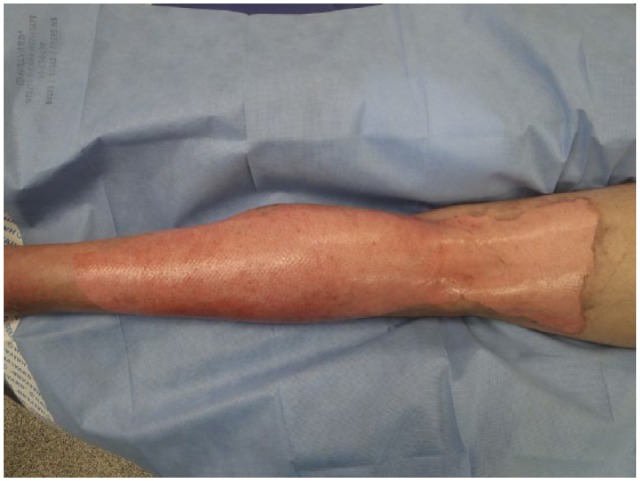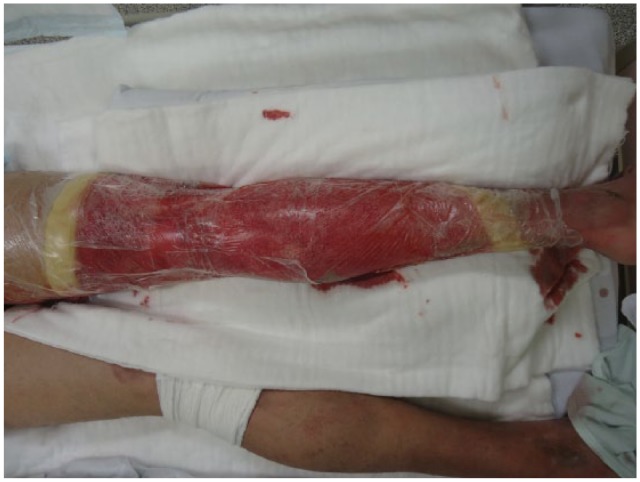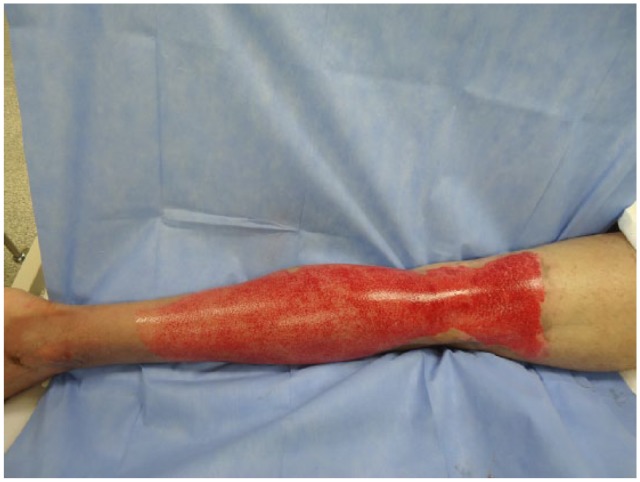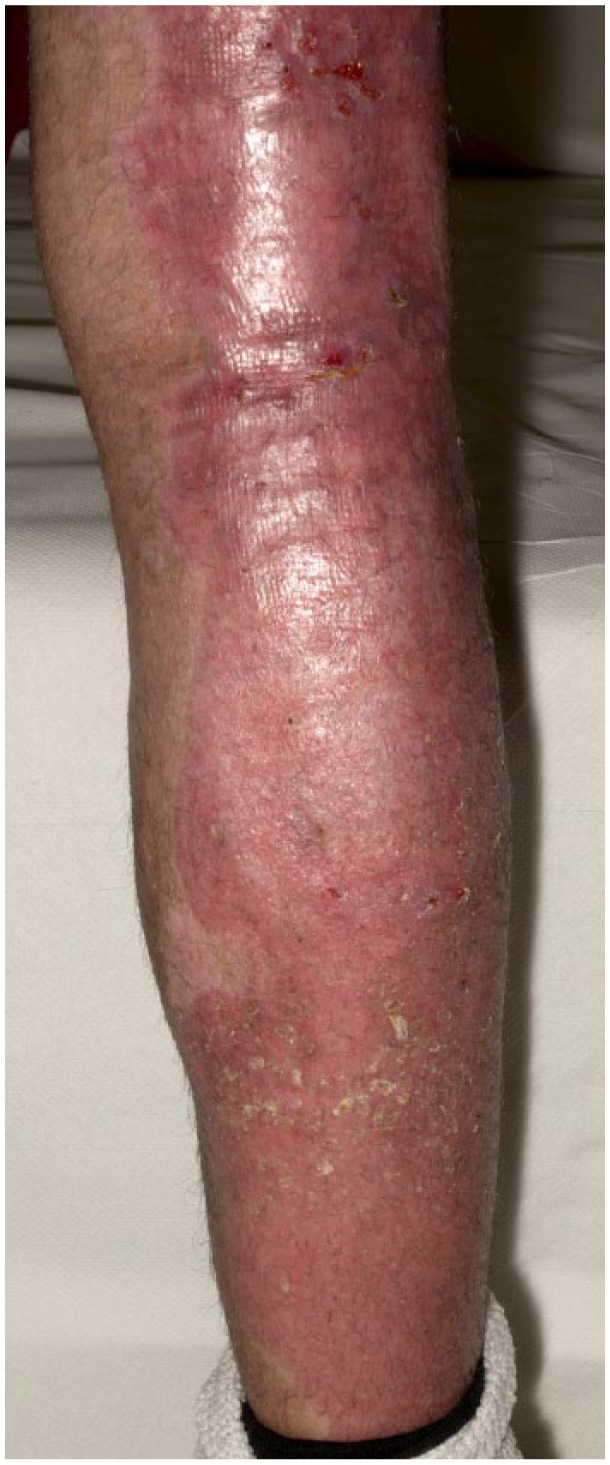Abstract
Introduction:
Enzymatic debridement for mixed depth and full thickness burns is gaining recognition as an important technique available to the burns surgeon. Reductions in blood loss, the need for autologous skin grafting and the number of wounds requiring surgical excision are among the benefits of this evolving treatment modality. We present a case of successful treatment using enzymatic debridement of mixed depth flame burns in a young patient with systemic sclerosis (scleroderma).
Methods:
A 24-year-old man with rapidly progressive limited cutaneous systemic sclerosis suffered approximately 6% mixed depth flame burns to the right leg including areas of likely deep partial thickness burn totalling approximately 2% total body surface area (TBSA). Enzymatic debridement using Nexobrid™ was performed under spinal anaesthesia in accordance with unit protocol. Pain was well controlled and at 4 h the Nexobrid™ was removed and replaced with saline-soaked gauze initially then simple dressings. After liaison with Rheumatology, he was also started on iloprost infusions over five days. He was discharged home on day 9 and completely healed by day 31. Scarring was minimal, the skin was soft and full, and pain-free range of movement of the right knee was maintained.
Discussion and Conclusion:
This case demonstrates the safety and effectiveness of enzymatic debridement of mixed depth burns in a patient with very compromised wound healing. Enzymatic debridement combined with iloprost infusion provided maximum preservation of viable dermis. The authors recommend that this treatment strategy is considered in similar cases.
Keywords: Wound, healing, impaired, microangiopathy, burns, scleroderma, enzymatic, debridement, Nexobrid™
Lay summary
This case report describes a patient with a flame burn injury to the leg who was successfully treated using an enzyme-based topical formulation. This product is increasingly being used to treat burn injuries of varying severity.
The patient had a pre-existing medical condition (scleroderma) which means that they have a significantly impaired ability to heal wounds following injury. The patient was also treated with a drug (iloporost) which can help wound healing in patients with this medical condition.
The topical enzyme used in this case is likely to have preserved all the viable tissue in the injured leg. This combined with the drug treatment (iloprost) helped heal the burn successfully with no complications and possibly eliminated the need for surgery.
Introduction
Enzymatic debridement for mixed depth and full thickness burns is gaining recognition as an important technique available to the burns surgeon. Reductions in blood loss, need for autologous skin grafting and the number of wounds requiring surgical excision are among the benefits of this evolving treatment modality.1 Nexobrid™ (Mediwound) is a concentrate of proteolytic enzymes derived from the pineapple leaf, enriched in bromelain. Indications for its use continue to expand. A recent European consensus statement recommended enzymatic debridement for thermal burns of up to 15% total body surface area (%TBSA), burns of the hands, face and feet and agreed that enzymatic debridement preserves more viable dermis, compared with surgical excision and skin grafting.1
Systemic sclerosis, also known as scleroderma, is a multi-system, autoimmune disease, characterised by functional and structural abnormalities of small blood vessels, fibrosis of skin and internal organs, and production of auto-antibodies.2 Micro-vessel vasculopathy is a key feature of the disease process resulting in spontaneous ulceration of extremities and significantly impaired wound healing. We present a case of successful treatment using enzymatic debridement of mixed depth flame burns in a young patient with rapidly progressive limited cutaneous systemic sclerosis.
Methods
A 24-year-old man had been diagnosed with rapidly progressing limited systemic sclerosis at the age of 19 years. He was under the care of a quaternary centre and was awaiting stem cell transplantation for systemic sclerosis. He suffered with spontaneous ulceration of digits and feet and had several small areas of ulceration at the time of injury. He also had reduced exercise tolerance and gastroesophageal reflux, but no other manifestations of systemic sclerosis. At the time of presentation, his regular medication included: omeprazole; mycophenelate mofetil; sildenafil; and nifedipine.
The patient suffered approximately 6%TBSA mixed depth flame burns to the right leg, following ignition of petrol used as an accelerant for a bonfire. This included areas of deep partial-thickness burn, totalling approximately 2%TBSA. Immediate first aid was applied with cool water for up to 1 h, before ambulance transfer to a local emergency department. Following analgesia, cleaning of burns and temporary dressing with sterile cling film, he was transferred to a UK regional burns unit. On assessment, the patient reported a pain score of 8/10 and it was observed that the burn involved areas of previous lower limb ulceration (Figure 1).
Figure 1.

Burn injury immediately before Nexobrid™ application.
Treatment options were discussed with the patient. He expressed a desire to have enzymatic debridement. At approximately 12 h after the burn, the pre-treatment soak was commenced, following a local treatment protocol. At approximately 16 h after the burn, the patient underwent spinal anaesthesia. A total of 7 g of Nexobrid™ was reconstituted and applied to the burn wound in the operating theatre. Clear film dressings were applied with rolled paraffin gauze at the edges (Figure 2) and the patient was returned to the ward. Pain scores were in the range of 4–6 out of 10 following Nexobrid™ application, with patient-controlled analgesia in addition to the spinal anaesthetic. Four hours later, the patient was returned to theatre where, under mild sedation, the Nexobrid™ was removed and immediate burn reassessment was undertaken (Figure 3). Sterile saline-soaked gauze was applied with continuous saline irrigation via Foley catheter directly into the gauze dressings used for the following 12 h. During this time, pain scores were in the range of 3–6 out of 10.
Figure 2.

After application of Nexobrid™ with dressings in situ.
Figure 3.

After removal of Nexobrid™.
Following liaison with Rheumatology, mycophenelate mofetil was discontinued. In addition, a course of iloprost infusions over five days were commenced. Dressings consisted of non-adherent silicone-based primary layers and sterile gauze. The patient was discharged from hospital at day 9 after the burn. Outpatient clinical review at day 25 revealed very small areas of over-granulation which were treated with topical steroid cream. Topical aqueous cream was applied to healed areas. At day 31 after the burn, all burned areas were fully healed (Figure 4). Scarring was minimal, the skin was soft and full, and pain-free range of movement was maintained.
Figure 4.

Day 31 after burn, completely healed with minimal scarring.
Discussion and conclusion
This case demonstrates the safety and effectiveness of enzymatic debridement of mixed depth burns, even in a patient with very compromised wound healing. In this case, enzymatic debridement provided maximum preservation of viable dermis. This facilitated rapid healing with minimal scarring in a patient who would be considered at high risk of graft failure, delayed healing and scarring complications.
The authors recognise the possibility that early tangential excision and split skin grafting may have resulted in quicker healing, i.e. less than 31 days. However, the patient’s history of poor peripheral wound healing and persistent areas of chronic ulceration suggest that surgery may not have accelerated healing and may have produced chronic donor site wounds. Additionally, tangential excision would almost certainly remove more viable dermal or subdermal elements than were removed enzymatically, resulting in more significant scarring and possible functional impairment.
The procedure was well tolerated. Intravenous iloprost treatment may also have facilitated successful wound healing and an excellent outcome in this case. The authors recommend that this treatment strategy is considered in similar cases.
Footnotes
Declaration of conflicting interests: The senior author Ciaran P O’Boyle is a member of the editorial board of Scars, Burns and Healing.
Funding: This research received no specific grant from any funding agency in the public, commercial, or not-for-profit sectors.
ORCID iD: Neil Wickham  https://orcid.org/0000-0001-5263-8100
https://orcid.org/0000-0001-5263-8100
References
- 1. Hirche C, Citterio A, Hoeksema H, et al. Eschar removal by bromelain based enzymatic debridement (Nexobrid) in burns: An European consensus. Burns 2017; 43(8): 1640–1653. [DOI] [PubMed] [Google Scholar]
- 2. Mayes MD. Systemic sclerosis (scleroderma). BMJ Best Practice. Available at: https://bestpractice.bmj.com/topics/en-gb/295 (accessed 2 August 2018).
How to cite this article
- Wickham N, Alexander KS, Fletcher A, O’Boyle C. Successful treatment of mixed depth flame burns using enzymatic debridement with Nexobrid™ in a patient with aggressive systemic sclerosis (scleroderma). Scars, Burns & Healing, Volume 5, 2019. DOI: 10.1177/2059513118821563 [DOI] [PMC free article] [PubMed] [Google Scholar]


